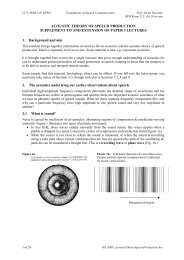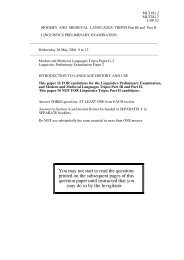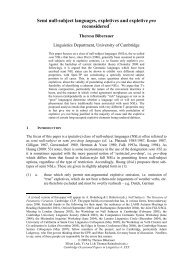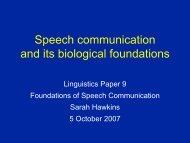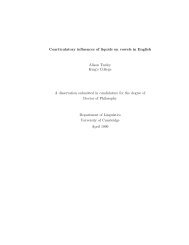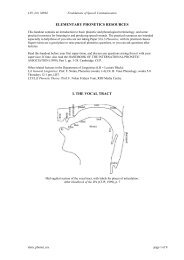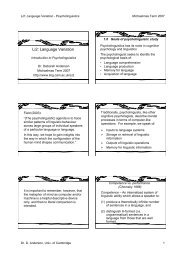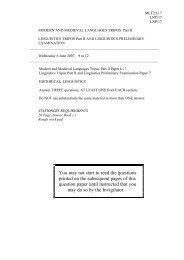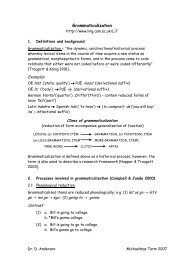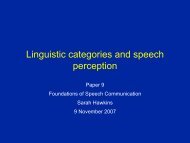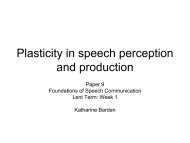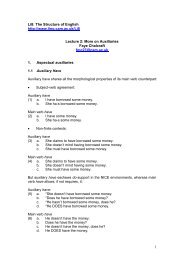Theories of L1 Acq. Dr. D. Anderson, U. of Camb. 1 ... - Ling.cam.ac.uk
Theories of L1 Acq. Dr. D. Anderson, U. of Camb. 1 ... - Ling.cam.ac.uk
Theories of L1 Acq. Dr. D. Anderson, U. of Camb. 1 ... - Ling.cam.ac.uk
Create successful ePaper yourself
Turn your PDF publications into a flip-book with our unique Google optimized e-Paper software.
<strong>Theories</strong> <strong>of</strong> <strong>L1</strong> <strong>Acq</strong>.<br />
Li2: Language Variation<br />
<strong>Theories</strong> <strong>of</strong> First Language <strong>Acq</strong>uisition<br />
<strong>Dr</strong>. Deborah <strong>Anderson</strong><br />
Michaelmas Term 2007<br />
http://www.ling.<strong>cam</strong>.<strong>ac</strong>.<strong>uk</strong>/Li2<br />
Generative vs. non-generative theories<br />
The above terms are preferred to nativist<br />
vs. non-nativis theories, which are also<br />
used in the literature.<br />
One reason is that it is perfectly possible for<br />
a researcher to reject the claim that children<br />
have innate linguistic ability, but<br />
nevertheless maintain that children have<br />
some innate non-linguistic ability (or<br />
abilities) that f<strong>ac</strong>ilitate language <strong>ac</strong>quisition.<br />
<br />
<br />
Philosophical tradition<br />
Empiricism (Locke & Hume)<br />
All knowledge is the product <strong>of</strong><br />
experience.<br />
Rationalism (Plato & Descartes)<br />
Some knowledge is innate.<br />
Corresponding theoretical divide in<br />
developmental psychology:<br />
Behaviourism (e.g. Skinner) – All<br />
behaviour, including linguistic, can be<br />
explained in terms <strong>of</strong> stimulus and<br />
response.<br />
Nativism (e.g. Chomsky)<br />
Experience as well as innate knowledge<br />
play a role in language <strong>ac</strong>quisition.<br />
It is generally <strong>ac</strong>cepted that pure<br />
empiricism, as espoused by Skinner,<br />
was effectively debunked as a credible<br />
theory <strong>of</strong> language <strong>ac</strong>quisition by<br />
Chomsky in an influential paper<br />
published in 1959 (see references at<br />
end <strong>of</strong> handout).<br />
A more contemporary divide is that<br />
which holds between:<br />
generative theories<br />
most notably, principles and<br />
parameters theory<br />
non-generative theories<br />
including distributive, constructivist,<br />
functionalist, or usage-based<br />
theories<br />
<strong>Dr</strong>. D. <strong>Anderson</strong>, U. <strong>of</strong> <strong>Camb</strong>. 1
<strong>Theories</strong> <strong>of</strong> <strong>L1</strong> <strong>Acq</strong>.<br />
One reasonably reliable means <strong>of</strong><br />
distinguishing the two theoretical <strong>cam</strong>ps<br />
is <strong>ac</strong>cording to whether language<br />
<strong>ac</strong>quisition is viewed as involving the use<br />
<strong>of</strong> language-specific and innately-given<br />
knowledge, which is standardly termed<br />
universal grammar (UG).<br />
As a rule, generative theories<br />
<strong>ac</strong>knowledge the role <strong>of</strong> UG, while nongenerative<br />
theories do not.<br />
Theoretical preliminaries<br />
Two defining char<strong>ac</strong>teristics <strong>of</strong> <strong>L1</strong><br />
<strong>ac</strong>quisition, which any theory <strong>of</strong> language<br />
<strong>ac</strong>quisition must take into <strong>ac</strong>count<br />
(Crain & Lillo-Martin 1999)<br />
Universality: Every normal child <strong>ac</strong>quires<br />
a natural language.<br />
Uniformity: Every language is learned<br />
with equal ease.<br />
The generative appro<strong>ac</strong>h<br />
Two core tenets <strong>of</strong> generative (or<br />
nativist) theory:<br />
<br />
<br />
No negative evidence<br />
Poverty <strong>of</strong> the stimulus<br />
The poverty <strong>of</strong> the stimulus (P.O.S.)<br />
“These, then, are the salient f<strong>ac</strong>ts about language<br />
<strong>ac</strong>quisition or, more properly, language growth.<br />
The child masters a rich system <strong>of</strong> knowledge<br />
without significant instruction and despite a …<br />
deficiency <strong>of</strong> experiential data. The process<br />
involves only a narrow range <strong>of</strong> “errors” or false<br />
hypotheses and takes pl<strong>ac</strong>e rapidly, even<br />
explosively, between two and three years <strong>of</strong> age.<br />
The main question is how children <strong>ac</strong>quire so<br />
much more than they experience.” (italics mine)<br />
Lightfoot (1999:64)<br />
The P.O.S. incorporates two separate<br />
contentions:<br />
1) Language <strong>ac</strong>quisition is <strong>ac</strong>hieved despite<br />
a deficiency <strong>of</strong> data/limited evidence.<br />
The input to the child is not uniformly<br />
grammatical, but contains speech errors,<br />
incomplete sentences, and other<br />
examples <strong>of</strong> ill-formed expressions.<br />
2) Certain linguistic knowledge is <strong>ac</strong>quired<br />
despite a l<strong>ac</strong>k <strong>of</strong> instruction or explicit<br />
evidence for the same.<br />
Example <strong>of</strong> grammatical knowledge the<br />
child <strong>ac</strong>quires which is not taught and<br />
which requires an understanding <strong>of</strong> nonobvious<br />
phrase structure relations:<br />
(1) a. Who do you wanna invite<br />
b. Who do you want to invite<br />
(2) a. When do you wanna go out<br />
b. When do you want to go out<br />
(3) a. *Who do you wanna come<br />
b. Who do you want to come<br />
<strong>Dr</strong>. D. <strong>Anderson</strong>, U. <strong>of</strong> <strong>Camb</strong>. 2
<strong>Theories</strong> <strong>of</strong> <strong>L1</strong> <strong>Acq</strong>.<br />
Why is (3a) is grammatically illformed<br />
as compared to the rest <strong>of</strong><br />
the sentences (See Guasti 2002:9)<br />
In generative theory, the focus is thus not<br />
only on the data that can be observed (e.g.<br />
the child’s production <strong>of</strong> well-formed<br />
sentences), but also on aspects <strong>of</strong> the child’s<br />
knowledge that are not directly observable<br />
(e.g. the child’s failure to produce<br />
grammatically ill-formed questions, which<br />
suggests conformance to certain synt<strong>ac</strong>tic<br />
rules <strong>of</strong> English).<br />
(See Pinker 1994:271-3 or <strong>Anderson</strong> & Lightfoot<br />
2002, Chapter 2, for further examples.)<br />
No negative evidence<br />
Negative evidence is neither reliably nor<br />
systematically supplied in the speech to<br />
which the child is exposed (i.e. the PLD<br />
or primary linguistic data)<br />
Furthermore, even when children are<br />
provided with negative evidence, they<br />
<strong>of</strong>ten disregard it.<br />
(Fromkin et al. 2003)<br />
Child: Want other one spoon, Daddy.<br />
Father: You mean you want THE OTHER SPOON<br />
Child: Yes, I want other one spoon, please,<br />
Daddy.<br />
Father: Can you say ‘the other spoon’<br />
Child: Other… one … spoon<br />
Father: Say ‘other.’<br />
Child: Other<br />
Father: Spoon<br />
Child: Spoon<br />
Father: Other… spoon<br />
Child: Other… spoon. Now give me the other one<br />
spoon. (Braine 1971)<br />
Examples from Pinker (1995:119)<br />
Parent:<br />
Child:<br />
Parent:<br />
Child:<br />
Where’s Mommy<br />
Mommy goed to the store.<br />
Mommy goed to the store<br />
No! (annoyed) Daddy, I say<br />
it that way, not you.<br />
<strong>Dr</strong>. D. <strong>Anderson</strong>, U. <strong>of</strong> <strong>Camb</strong>. 3
<strong>Theories</strong> <strong>of</strong> <strong>L1</strong> <strong>Acq</strong>.<br />
Child: (a different one): You readed some<br />
<strong>of</strong> it too … she readed all the rest.<br />
Parent: She read the whole thing to you,<br />
huh<br />
Child: Nu-uh, you read some.<br />
Parent: No, that’s right. I readed the<br />
beginning <strong>of</strong> it.<br />
Child: Readed (annoyed surprise) Read!<br />
(pronounced ‘red’)<br />
Parent: Oh, yeah. Read.<br />
Child: Will you stop that, Papa<br />
For the aforementioned reasons,<br />
then, it is claimed in the generative<br />
literature that provision <strong>of</strong> negative<br />
evidence is neither required nor<br />
sufficient for the successful<br />
<strong>ac</strong>quisition <strong>of</strong> a first language.<br />
Principle and parameters (P&P) theory<br />
(Chomsky 1981;1986)<br />
In the P&P model <strong>of</strong> language <strong>ac</strong>quisition,<br />
universal principles constrain the basic<br />
form <strong>of</strong> any grammar, while parameters<br />
specify limited and pre-determined ways in<br />
which the grammars <strong>of</strong> individual<br />
languages may vary.<br />
According to the theory, both types <strong>of</strong><br />
information are specified as part <strong>of</strong><br />
universal grammar (UG), an innate,<br />
biologically-specified mental f<strong>ac</strong>ulty that<br />
strongly directs the course <strong>of</strong> language<br />
<strong>ac</strong>quisition.<br />
Examples <strong>of</strong> UG principles (Pinker 1994;1995)<br />
Children are born with innate knowledge <strong>of</strong><br />
the existence <strong>of</strong>:<br />
(1) synt<strong>ac</strong>tic categories (e.g. noun, sentence)<br />
(2) grammatical functions (e.g. subject,<br />
object)<br />
(3) grammatical features (e.g.tense, number)<br />
(4) case features (e.g. nominative, absolutive)<br />
(5) phrase structure configurations (i.e. X-bar<br />
theory or phrase tree structures)<br />
The child’s task therefore is simply to<br />
identify how these grammatical<br />
elements are expressed in the<br />
particular language he/she is learning,<br />
(e.g. English, Turkish, Chinese, etc.)<br />
<strong>Dr</strong>. D. <strong>Anderson</strong>, U. <strong>of</strong> <strong>Camb</strong>. 4
<strong>Theories</strong> <strong>of</strong> <strong>L1</strong> <strong>Acq</strong>.<br />
Example <strong>of</strong> a UG parameter<br />
Head/directionality parameter, which<br />
specifies that languages may vary in<br />
terms <strong>of</strong> whether the heads <strong>of</strong> phrases<br />
(e.g. verbs) take their complements to<br />
the left or to the right (cf. John hit the<br />
girl vs. John the girl hit).<br />
Children <strong>ac</strong>quiring English must adopt<br />
the [+ initial] value <strong>of</strong> this parameter,<br />
while children <strong>ac</strong>quiring Japanese, in<br />
which heads take their complements to<br />
the left, must adopt the negative value,<br />
[- initial]. (see Goodluck 1991)<br />
Supportive evidence for P&P Theory<br />
A. Children’s early sensitivity<br />
to the synt<strong>ac</strong>tic properties<br />
<strong>of</strong> speech<br />
Preferential Looking Paradigm (Hirsh-Pasek & Golink<strong>of</strong>f 1996)<br />
Hirsh-Pasek and Golink<strong>of</strong>f (1996)<br />
14-month-old infants hear the sentence<br />
Hey! She’s kissing the keys! Subjects<br />
looked longer at the screen depicting a<br />
woman kissing some keys while holding<br />
a ball, than at the screen depicting a<br />
woman kissing a ball while holding<br />
some keys.<br />
This would seem to demonstrate, at<br />
the very least, that infants are<br />
sensitive to the grouping <strong>of</strong> basic<br />
sentential constituents.<br />
(But see Tomasello 2003:127-32 for<br />
an dissenting view).<br />
<strong>Dr</strong>. D. <strong>Anderson</strong>, U. <strong>of</strong> <strong>Camb</strong>. 5
<strong>Theories</strong> <strong>of</strong> <strong>L1</strong> <strong>Acq</strong>.<br />
More supportive evidence<br />
B. Creoles<br />
Kegl et al. (1999) – Creolization <strong>of</strong> a<br />
sign-language pidgin by deaf<br />
Nicaraguan children, who were raised<br />
by non-signing parents.<br />
Bickerton (1988) – The Bioprogram<br />
Hypothesis. Advanced to explain striking<br />
similarities in the grammatical properties<br />
<strong>of</strong> creoles throughout the world.<br />
See also Newport’s (1999) discussion <strong>of</strong><br />
children <strong>ac</strong>quiring sign languages (e.g.<br />
Simon).<br />
C. Cases <strong>of</strong> dissociation between<br />
general cognitive ability and linguistic<br />
performance<br />
• Laura (Yamada 1990)<br />
• Christopher (Smith and Tsimpli 1995)<br />
• William’s syndrome<br />
• SLI (Specific Language Impairment)<br />
The non-generative appro<strong>ac</strong>h<br />
As earlier noted, non-generative<br />
theories are in<strong>ac</strong>curately described as<br />
purely empiricist since even nongenerative<br />
researchers <strong>ac</strong>cept that<br />
certain biological f<strong>ac</strong>tors influence<br />
cognitive – and, therefore, linguistic –<br />
development.<br />
All such researchers, however, reject<br />
the generative notion <strong>of</strong> an innately<br />
specified, language-specific<br />
module/f<strong>ac</strong>ulty that guides language<br />
<strong>ac</strong>quisition.<br />
“In usage-based appro<strong>ac</strong>hes,<br />
contentless rules, principles,<br />
parameters, constraints, features, and<br />
so forth are the formal devices <strong>of</strong><br />
pr<strong>of</strong>essional linguists; they simply do<br />
not exist in the minds <strong>of</strong> speakers <strong>of</strong> a<br />
natural language.”<br />
Tomasello (2003:100)<br />
<strong>Dr</strong>. D. <strong>Anderson</strong>, U. <strong>of</strong> <strong>Camb</strong>. 6
<strong>Theories</strong> <strong>of</strong> <strong>L1</strong> <strong>Acq</strong>.<br />
Core tenets <strong>of</strong> non-generative theory<br />
<br />
<br />
Language is <strong>ac</strong>quired through the<br />
application <strong>of</strong> general learning<br />
strategies and not language-specific<br />
ones.<br />
The communicative function <strong>of</strong><br />
language is central, as it is language<br />
use that dictates the form <strong>of</strong> the<br />
knowledge that the learner <strong>ac</strong>quires.<br />
<br />
The developmental course <strong>of</strong><br />
language <strong>ac</strong>quisition is subject to<br />
variation <strong>ac</strong>cording to differences<br />
in individual ability/individual<br />
experience/grammatical<br />
properties <strong>of</strong> various languages.<br />
Cognitive Functional Appro<strong>ac</strong>h<br />
(Tomasello 2000, 2001, 2003)<br />
Two fundamental abilities underlie <strong>ac</strong>quisition<br />
<strong>of</strong> a first language:<br />
1. intention-reading (i.e. theory <strong>of</strong> mind)<br />
incorporates shared attention, direction <strong>of</strong><br />
attention and imitation<br />
2. pattern-finding<br />
incorporates categorisation, distributional<br />
analysis, and making analogies<br />
Central claim: Children’s early linguistic<br />
competence is item-based: abstr<strong>ac</strong>t<br />
synt<strong>ac</strong>tic categories and ‘schemas’ emerge<br />
gradually and in piecemeal fashion.<br />
Tomasello’s (1992) diary study <strong>of</strong> his own<br />
daughter’s linguistic development during<br />
her second year revealed that her use <strong>of</strong><br />
verbs was considerably restricted compared<br />
to adult-like use <strong>of</strong> the same items.<br />
At the same stage <strong>of</strong> development, his<br />
daughter used semantically similar verbs<br />
in very distinct ways:<br />
cut (X) – Sole usage <strong>of</strong> this verb<br />
vs.<br />
wider use <strong>of</strong> the verb draw:<br />
draw (W) ; draw (W) on (X); draw (W)<br />
for (Y); draw on (Z)<br />
For draw:<br />
“draw-er” (vs. subject)<br />
“thing drawn” (vs. object)<br />
“thing drawn with” (vs. instrument)<br />
For cut:<br />
“thing cut” (vs. object)<br />
No evidence that argument structure <strong>of</strong><br />
cut includes a subject or an instrument,<br />
so no evidence yet for generalization <strong>of</strong><br />
these notions.<br />
<strong>Dr</strong>. D. <strong>Anderson</strong>, U. <strong>of</strong> <strong>Camb</strong>. 7
<strong>Theories</strong> <strong>of</strong> <strong>L1</strong> <strong>Acq</strong>.<br />
Additionally:<br />
• Morphological marking (e.g. past<br />
tense) was uneven <strong>ac</strong>ross individual<br />
verbs.<br />
• The best predictor <strong>of</strong> her verb usage<br />
the next day was not her use <strong>of</strong><br />
other verbs but rather her use <strong>of</strong><br />
the same verb. Changes were<br />
conservative, typically involving only<br />
a small addition or modification.<br />
Some item-based schemas <strong>of</strong> a 24-month-old child<br />
(Tomasello 2003:120)<br />
Other item-based patterns in linguistic<br />
development:<br />
Rubino & Pine (1998) – Studied 3-<br />
yr-old child learning Brazilian<br />
Portuguese. Child produced adultlike<br />
subject-verb agreement only for<br />
those verbs that occurred with high<br />
frequency in the adult language<br />
(e.g. 1 st person singular).<br />
Berman & Armon-Lotem (1995) –<br />
Studied children <strong>ac</strong>quiring Hebrew.<br />
First 20 verb forms were nearly all<br />
morphologically unanalyzed,<br />
suggesting rote-learning alone.<br />
Notably, the cognitive-functional<br />
<strong>ac</strong>count strongly predicts individual<br />
variation in language development, in<br />
contrast to generative theories which<br />
typically emphasize developmental<br />
uniformity <strong>ac</strong>ross individuals.<br />
Reading Recommendations<br />
Generative (or nativist) theories <strong>of</strong> first language<br />
<strong>ac</strong>quisition<br />
Crain, S. and D. Lillo Martin. 1999. An Introduction<br />
to <strong>Ling</strong>uistic Theory and Language <strong>Acq</strong>uisition.<br />
Bl<strong>ac</strong>kwell. (Part I, pp. 1-70, is highly recommended.)<br />
<strong>Anderson</strong>, S. and D. Lightfoot. 2002. The Language<br />
Organ: <strong>Ling</strong>uistics as Cognitive Physiology. CUP.<br />
(Chapter 2 <strong>of</strong>fers examples <strong>of</strong> potential violations <strong>of</strong> UG<br />
constraints that are not attested in child language.)<br />
<strong>Dr</strong>. D. <strong>Anderson</strong>, U. <strong>of</strong> <strong>Camb</strong>. 8
<strong>Theories</strong> <strong>of</strong> <strong>L1</strong> <strong>Acq</strong>.<br />
Pinker, S. 1995. ‘Language <strong>ac</strong>quisition’ in L.<br />
Gleitman, L. & M. Liberman (eds.) Language: An<br />
Invitation to Cognitive Science. 2 nd ed. Vol. 1: 135-<br />
182.<br />
Gleitman, L. & E. Newport, 1995. ‘The invention <strong>of</strong><br />
language by children’ in L. Gleitman & M. Liberman<br />
(eds.) Language: An Invitation to Cognitive Science.<br />
2 nd ed. Vol. 1: 1-24. MIT Press. (Contains a<br />
discussion <strong>of</strong> blind children’s <strong>ac</strong>quisition <strong>of</strong> language.)<br />
Guasti, M.T. 2002. Language <strong>Acq</strong>uisition: The<br />
Growth <strong>of</strong> Grammar. MIT Press. (An advanced<br />
source)<br />
J<strong>ac</strong>kend<strong>of</strong>f, R. 2002. Foundations <strong>of</strong> Language:<br />
Brain, Meaning, Grammar, Evolution. OUP. (See<br />
especially Chapter 4, Universal Grammar, where<br />
standard arguments against generative theory are<br />
reviewed and refuted.)<br />
Lust, B. and C. Foley. 2004. First Language<br />
<strong>Acq</strong>uisition: The Essential Readings. Bl<strong>ac</strong>kwell.<br />
(Contains reprints <strong>of</strong> important papers, including Chomsky<br />
1959, Lenneberg 1967 and Brown 1973.)<br />
Russell, J. 2004. What is Language Development:<br />
Rationalist, Empiricist and Pragmatist Appro<strong>ac</strong>hes to<br />
the <strong>Acq</strong>uisition <strong>of</strong> Syntax. OUP.<br />
Non-generative (or non-nativist) theories <strong>of</strong><br />
language <strong>ac</strong>quisition<br />
Tomasello, M. 2003. Constructing a Language: A<br />
Usage-Based Theory <strong>of</strong> Language <strong>Acq</strong>uisition.<br />
Harvard University Press. (Chapter 4, ‘Early synt<strong>ac</strong>tic<br />
constructions’, is highly recommended.)<br />
Clark, E. 2002. First Language <strong>Acq</strong>uisition. CUP.<br />
(Chapter 7, ‘First combinations, first constructions’)<br />
Tomasello, M. 2001. ‘The item-based nature <strong>of</strong><br />
children’s early synt<strong>ac</strong>tic development.’ In M.<br />
Tomasello and E. Bates (eds.) Language<br />
Development: Essential Readings. Bl<strong>ac</strong>kwell.<br />
Slobin, D. 2001. ‘Form/function relations: How<br />
do children find out what they are’ In M.<br />
Tomasello and E. Bates (eds.) Language<br />
Development: Essential Readings. Bl<strong>ac</strong>kwell.<br />
Snow, C.E. 1999. ‘Social perspectives on the<br />
emergence <strong>of</strong> language’ in M<strong>ac</strong>Whinney, B (ed.)<br />
The Emergence <strong>of</strong> Language. Lawrence Erlbaum.<br />
Elman, J. 2001. ‘Connectionism and language<br />
<strong>ac</strong>quisition.’ In M. Tomasello and E. Bates (eds.)<br />
Language Development: Essential Readings.<br />
Bl<strong>ac</strong>kwell. (A short introductory level paper.)<br />
Elman, J. 1999. ‘The emergence <strong>of</strong> language: A<br />
consipir<strong>ac</strong>y theory’ in B. M<strong>ac</strong>Whinney (ed.) The<br />
Emergence <strong>of</strong> Language. Lawrence Erlbaum.<br />
(Examines the issue <strong>of</strong> innateness from a<br />
neurophysiological perspective.)<br />
Tomasello, M. 2000. ‘Do young children have adult<br />
synt<strong>ac</strong>tic competence’ Cognition 74: 209-53.<br />
Other sources<br />
Bickerton, D. 1988. ‘Creole languages and the<br />
bioprogram.’ In Newmeyer, F.J. (ed.) <strong>Ling</strong>uistics: the<br />
<strong>Camb</strong>ridge Survey. Vol. 2: <strong>Ling</strong>uistic Theory,<br />
Extensions and Implications. CUP.<br />
Kegl, J., A. Senghas, and M. Coppola. 1999. ‘Creation<br />
through cont<strong>ac</strong>t’ in M. DeGraff (ed.) Language Creation and<br />
Language Change: Creolization, Di<strong>ac</strong>hrony and<br />
Development. MIT Press.<br />
Yamada, J. 1990. Laura: A Case Study for the Modularity <strong>of</strong><br />
Language. MIT Press.<br />
Smith, N. & I. Tsimpli. 1995. The Mind <strong>of</strong> a Savant:<br />
Language Learning and Modularity. Bl<strong>ac</strong>kwell. (Discussion<br />
<strong>of</strong> the linguistic savant Christopher.)<br />
Newport, E. 1999. ‘Reduced input in the <strong>ac</strong>quisition <strong>of</strong><br />
signed languages’ in M. DeGraff (ed.) Language Creation<br />
and Language Change: Creolization, Di<strong>ac</strong>hrony and<br />
Development. MIT Press. (Discussion <strong>of</strong> Simon.)<br />
<strong>Dr</strong>. D. <strong>Anderson</strong>, U. <strong>of</strong> <strong>Camb</strong>. 9



